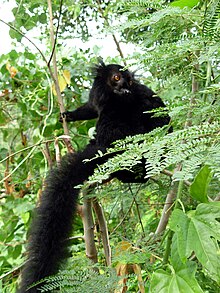Ordinary makis
| Ordinary makis | ||||||||||||
|---|---|---|---|---|---|---|---|---|---|---|---|---|

Katta ( lemur catta ) |
||||||||||||
| Systematics | ||||||||||||
|
||||||||||||
| Scientific name | ||||||||||||
| Lemuridae | ||||||||||||
| Gray , 1821 |
The common Makis (Lemuridae) are a primate family from the group of lemurs (Lemuriformes). It includes around 20 living and at least two extinct species. The lemurs and weasel lemurs , which used to be included in this family, are now regarded as separate families.
features
The living representatives of the common Makis reach a head body length of 24 to 57 centimeters, the tail is always longer than the body with 32 to 65 centimeters. Their weight is 0.7 to 4 kilograms - the extinct animals of the genus Pachylemur , however, were somewhat larger. As with all lemurs, the sexes are almost the same size, but the great Makis (genus Eulemur ) usually differ significantly in the color of their fur. The fur of these animals is soft, dense and woolly, it is usually colored in gray, brown or black tones. Sometimes there is bushy hair on the ears, on the cheeks or on the chin. Your physique is relatively generalized. The trunk is delicate, the limbs are slender, and the long tail is densely hairy. The hind legs are slightly longer than the front legs, all fingers and toes wear nails except for all wet-nosed monkeys existing grooming claw on the second toe.
The snout is short in the bamboo lemurs and large bamboo lemurs , in the other genera elongated and dog-like. The tooth formula is I 2 / 2- C 1 / 1- P 3 / 3- M 3/3, so you have a total of 36 teeth. The upper incisors are small and pin-like, the canines are somewhat enlarged. As in most wet-nosed monkeys, the lower incisors and canines form a tooth comb .
distribution and habitat
The common makis, like all lemurs, are restricted to Madagascar , but two species (the Mongozmaki and the brown maki ) were settled on the Comoros. In Madagascar they live in the dry forests in the west as well as in the rainforests in the east of the island, some species - especially the ring-tailed lemur - also inhabit the dry regions in the southwest. However, they are missing in the central, unforested highlands.
Lifestyle and diet
These primates are mainly in the trees, but the ring-tailed lemur (and possibly also the extinct Pachylemur ) can be found on the ground to a considerable extent. In the trees they usually move with four-legged climbing and jumping. In contrast to most other lemurs, they are not purely nocturnal, but rather diurnal or cathemeral , that is, without a pronounced day-night rhythm.
They live in groups, these can either be family groups or larger groups with several males and females. The grazing areas are marked with glandular secretions, for example with glands on the wrist or with perianal glands . The animals also communicate with each other with various sounds, so a distinction was made between around 30 sounds in the ring-tailed lemur.
The Makis are mainly herbivores , their diet consists primarily of fruits and leaves and in the case of the bamboo lemurs, of bamboo . Depending on the species, habitat and season, they also consume other parts of the plant to varying degrees. Some species also eat meat to a small extent, such as insects , spiders and millipedes or even small vertebrates .
Reproduction
In most species of common maki, females have a pair of teats and give birth to singles. In the case of the Varis, on the other hand, the females have three pairs of teats and twin or triplet births predominate. Reproduction is seasonal in all species, with most births occurring between September and December. The gestation period for the Varis is 90 to 100 days, for the other species it is 125 to 150 days. When rearing young, the Varis also vary from the other genera: they build leaf nests in which the newborns spend their first weeks of life, while in the other genera the mothers carry their young around with them or "park" them in a protected place while foraging for food. After several months, the young are weaned and sexually mature at two to four years of age. After a gestation period of 90 to 150 days, one or two young are born between August and October (just before the start of the rainy season ). They are weaned after around five months and sexually mature after two to three years.
threat
Almost all species of common Makis are endangered species. The main reasons for this are the destruction of their habitat due to slash and burn , deforestation, charcoal production and mining, and hunting. The distribution areas of most species have been significantly reduced and fragmented in the last few decades. The majority of the species is, according to IUCN "at risk" ( vulnerable ), some are "high risk" ( endangered ) or "to extinction" ( critically endangered ). The species of the genus Pachylemur have become extinct in the last 1000 years, for which humans are at least partly responsible.
Systematics
The common makis are one of five living families into which the lemurs are divided today. The ancestry relationships within the lemurs are not completely clarified, the Indri-like possibly form the sister taxon of this group.
There are 6 genera and over 20 species:
- Genus Varis ( Varecia )
- Black and White Vari ( Varecia variegata )
- Red Vari ( Varecia rubra )
- Genus Pachylemur †, two species
- Genus lemur
- Katta ( lemur catta )
- Genus Great Makis ( Eulemur )
- Bald Lemur ( Eulemur albifrons )
- White-collar lemur ( Eulemur cinereiceps , Syn . : E. albocollaris )
- Collared lemur ( Eulemur collaris )
- Crowned Lemur ( Eulemur coronatus )
- Blue-eyed lemur ( Eulemur flavifrons )
- Brown Maki ( Eulemur fulvus )
- Mohrenmaki ( Eulemur macaco )
- Mongozmaki ( Eulemur mongoz )
- Red-bellied lemur ( Eulemur rubriventer )
- Red- fronted lemur ( Eulemur rufifrons )
- Red Maki ( Eulemur rufus )
- Sanford Maki ( Eulemur sanfordi )
- Genus bamboo lemurs or half lemurs ( Hapalemur )
- Eastern bamboo lemur ( Hapalemur griseus )
- Southern bamboo lemur ( Hapalemur meridionalis )
- Western bamboo lemur or Sambirano bamboo lemur ( Hapalemur occidentalis )
- Alaotra bamboo lemur ( Hapalemur alaotrensis )
- Gilbert bamboo lemur ( Hapalemur gilberti )
- Golden bamboo lemur ( Hapalemur aureus )
- Genus Prolemur
- Great bamboo lemur ( Prolemur simus )
The division into the short-snouted Hapalemurinae (genera Hapalemur and Prolemur ) and the long-snouted Lemurinae (the other genera), which was often made in the past, can no longer be maintained due to genetic studies. Rather, the Varis are the sister group of the other species and the ring-tailed lemur is most closely related to the bamboo lemurs despite external similarities with the Great Makis. The parentage relationships within the living genera are expressed in the following cladogram :
| Common Makis (Lemuridae) |
|
||||||||||||||||||||||||
|
|
literature
- Thomas Geissmann : Comparative Primatology. Springer-Verlag, Berlin et al. 2002, ISBN 3-540-43645-6 .
- Russell A. Mittermeier , Jörg U. Ganzhorn, William R. Konstant , Kenneth Glander, Ian Tattersall , Colin P. Groves , Anthony B. Rylands , Andreas Hapke, Jonah Ratsimbazafy, Mireya I. Mayor, Edward Louis jr, Yves Rumpler, Christoph Schwitzer , Rodin Rasoloarison: Lemur Diversity in Madagascar. In: International Journal of Primatology. 29, 2008, ISSN 0164-0291 , pp. 1607-1656.
- Ronald M. Nowak: Walker's Mammals of the World. 6th edition. Johns Hopkins University Press, Baltimore MD 1999, ISBN 0-8018-5789-9 .


